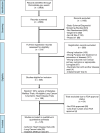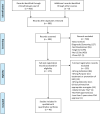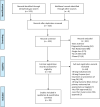The proportion of randomized controlled trials that inform clinical practice
- PMID: 35975784
- PMCID: PMC9427100
- DOI: 10.7554/eLife.79491
The proportion of randomized controlled trials that inform clinical practice
Abstract
Prior studies suggest that clinical trials are often hampered by problems in design, conduct, and reporting that limit their uptake in clinical practice. We have described 'informativeness' as the ability of a trial to guide clinical, policy, or research decisions. Little is known about the proportion of initiated trials that inform clinical practice. We created a cohort of randomized interventional clinical trials in three disease areas (ischemic heart disease, diabetes mellitus, and lung cancer) that were initiated between January 1, 2009 and December 31, 2010 using ClinicalTrials.gov. We restricted inclusion to trials aimed at answering a clinical question related to the treatment or prevention of disease. Our primary outcome was the proportion of clinical trials fulfilling four conditions of informativeness: importance of the clinical question, trial design, feasibility, and reporting of results. Our study included 125 clinical trials. The proportion meeting four conditions for informativeness was 26.4% (95% CI 18.9-35.0). Sixty-seven percent of participants were enrolled in informative trials. The proportion of informative trials did not differ significantly between our three disease areas. Our results suggest that the majority of randomized interventional trials designed to guide clinical practice possess features that may compromise their ability to do so. This highlights opportunities to improve the scientific vetting of clinical research.
Keywords: clinical trials; informative research; medicine; none; research ethics.
© 2022, Hutchinson et al.
Conflict of interest statement
NH, HM No competing interests declared, DZ received payment as consultant for National Library of Medicine, NIH, for scientific advice to ClinicalTrials.gov and received grants from the Greenwall Foundation, JK received consulting fees from Amylyx Inc and payments from Biomarin. JK participated on Data Safety Monitoring Boards for NIAID and Ultragenyx
Figures







Similar articles
-
Improving Trial Informativeness: A Rapid Review of Global Research on How to Ensure Trials Are Useful.J Eval Clin Pract. 2025 Jun;31(4):e70147. doi: 10.1111/jep.70147. J Eval Clin Pract. 2025. PMID: 40499566 Free PMC article. Review.
-
The future of Cochrane Neonatal.Early Hum Dev. 2020 Nov;150:105191. doi: 10.1016/j.earlhumdev.2020.105191. Epub 2020 Sep 12. Early Hum Dev. 2020. PMID: 33036834
-
Safety and Efficacy of Imatinib for Hospitalized Adults with COVID-19: A structured summary of a study protocol for a randomised controlled trial.Trials. 2020 Oct 28;21(1):897. doi: 10.1186/s13063-020-04819-9. Trials. 2020. PMID: 33115543 Free PMC article.
-
Shortened treatment regimens versus the standard regimen for drug-sensitive pulmonary tuberculosis.Cochrane Database Syst Rev. 2019 Dec 12;12(12):CD012918. doi: 10.1002/14651858.CD012918.pub2. Cochrane Database Syst Rev. 2019. PMID: 31828771 Free PMC article.
-
Virtualized clinical studies to assess the natural history and impact of gut microbiome modulation in non-hospitalized patients with mild to moderate COVID-19 a randomized, open-label, prospective study with a parallel group study evaluating the physiologic effects of KB109 on gut microbiota structure and function: a structured summary of a study protocol for a randomized controlled study.Trials. 2021 Apr 2;22(1):245. doi: 10.1186/s13063-021-05157-0. Trials. 2021. PMID: 33810796 Free PMC article.
Cited by
-
Tracing the path of 37,050 studies into practice across 18 specialties of the 2.4 million published between 2011 and 2020.Elife. 2023 Feb 28;12:e82498. doi: 10.7554/eLife.82498. Elife. 2023. PMID: 36852916 Free PMC article.
-
Scientific review of protocols to enhance informativeness of global health clinical trials.Trials. 2025 Mar 12;26(1):85. doi: 10.1186/s13063-025-08763-4. Trials. 2025. PMID: 40075544 Free PMC article.
-
Improving Trial Informativeness: A Rapid Review of Global Research on How to Ensure Trials Are Useful.J Eval Clin Pract. 2025 Jun;31(4):e70147. doi: 10.1111/jep.70147. J Eval Clin Pract. 2025. PMID: 40499566 Free PMC article. Review.
-
Analysis of control arms in oncology randomised trials in Brazil: a cross-sectional study.BMJ Oncol. 2025 Aug 4;4(1):e000808. doi: 10.1136/bmjonc-2025-000808. eCollection 2025. BMJ Oncol. 2025. PMID: 40765840 Free PMC article.
-
Spontaneous Scaling of a Primary Care Innovation in Real-Life Conditions: Protocol for a Case Study.JMIR Res Protoc. 2023 Dec 28;12:e54855. doi: 10.2196/54855. JMIR Res Protoc. 2023. PMID: 38032757 Free PMC article.
References
Publication types
MeSH terms
Grants and funding
LinkOut - more resources
Full Text Sources

